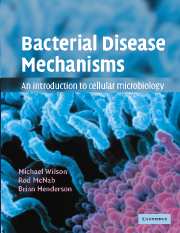Book contents
- Frontmatter
- Contents
- Preface
- Abbreviations used
- Chapter 1 An introduction to bacterial diseases
- Chapter 2 Bacterial cell biology
- Chapter 3 Molecular analysis of bacterial virulence mechanisms
- Chapter 4 Communication in infection
- Chapter 5 The mucosal surface: the front line of antibacterial defence
- Chapter 6 Immune defences against bacteria
- Chapter 7 Bacterial adhesion as a virulence mechanism
- Chapter 8 Bacterial invasion as a virulence mechanism
- Chapter 9 Bacterial exotoxins
- Chapter 10 Bacterial evasion of host defence mechanisms
- Chapter 11 Bacteria in human health and disease: the future?
- Appendix A Glossary of terms used
- Appendix B Brief descriptions of bacteria frequently mentioned
- Index
- Plate section
Chapter 3 - Molecular analysis of bacterial virulence mechanisms
Published online by Cambridge University Press: 05 June 2012
- Frontmatter
- Contents
- Preface
- Abbreviations used
- Chapter 1 An introduction to bacterial diseases
- Chapter 2 Bacterial cell biology
- Chapter 3 Molecular analysis of bacterial virulence mechanisms
- Chapter 4 Communication in infection
- Chapter 5 The mucosal surface: the front line of antibacterial defence
- Chapter 6 Immune defences against bacteria
- Chapter 7 Bacterial adhesion as a virulence mechanism
- Chapter 8 Bacterial invasion as a virulence mechanism
- Chapter 9 Bacterial exotoxins
- Chapter 10 Bacterial evasion of host defence mechanisms
- Chapter 11 Bacteria in human health and disease: the future?
- Appendix A Glossary of terms used
- Appendix B Brief descriptions of bacteria frequently mentioned
- Index
- Plate section
Summary
Aims
The principal aims of this chapter are:
to describe the various molecular approaches that have been developed (in both bacteria and eukaryotic cells) to identify bacterial virulence factors
to highlight the advantages and limitations of each method
to provide examples of the application of molecular techniques to answer questions about pathogen behaviour during infection
Introduction
As described in the Preface to this book, there has been an alarming rise in the incidence of antibiotic resistance amongst bacterial pathogens during the last few years. The boast of the Surgeon General, in his address to the USA Congress in 1969, that ‘we can close the book on infectious diseases’ sounds very hollow now as we witness the resurgence of diseases caused by pathogens such as Mycobacterium tuberculosis and Streptococcus pyogenes. We also face a myriad new infectious agents that are emerging as the world shrinks, through international travel and migration, and as population demographics change. Understanding how bacteria cause disease is, consequently, high on the agenda once again.
Some fundamental aspects of bacterial virulence have been investigated in great detail. These include bacterial adhesion, invasion and the production of exotoxins, and these topics are covered in later chapters in this book. However, the results arising from the use of new molecular techniques, described in this chapter, are forcing us to broaden our idea of what we mean by the term ‘virulence factor’.
- Type
- Chapter
- Information
- Bacterial Disease MechanismsAn Introduction to Cellular Microbiology, pp. 111 - 161Publisher: Cambridge University PressPrint publication year: 2002



